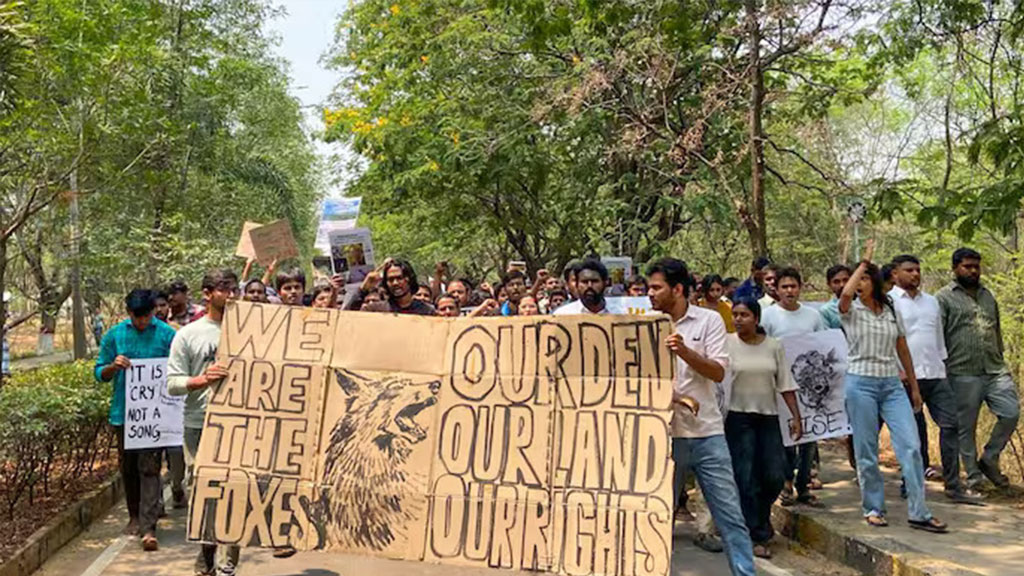Land Conflict and Environmental Degradation: Telangana’s IT park initiative jeopardizes green areas
The rapid expansion of Information Technology (IT) infrastructure in Telangana has ignited significant debates concerning land conflicts and environmental degradation. A prominent example is the controversy surrounding the proposed development of IT parks in the Kancha Gachibowli forested area adjacent to the University of Hyderabad (UoH). This situation underscores the delicate balance between economic development and ecological preservation.

Background of the Conflict
The Telangana government’s initiative to auction land in the Kancha Gachibowli area for IT park development has faced opposition from environmentalists, UoH students, and local residents. The primary concern is the potential destruction of green spaces, which serve as vital ecological zones and recreational areas for the community. In response to the backlash, the government proposed establishing an ‘eco park’ as an alternative. However, critics question the authenticity of this move, suspecting it might be a strategic concession rather than a genuine commitment to conservation.
Environmental Implications
The proposed development poses several environmental risks:
1. Loss of Biodiversity: The Kancha Gachibowli forested area is home to various flora and fauna. Clearing this land for construction could lead to the displacement or extinction of local species.
2. Urban Heat Island Effect: Reducing green cover can contribute to higher local temperatures, exacerbating the urban heat island effect and leading to increased energy consumption for cooling.
3. Air Quality Deterioration: Trees act as natural air filters. Their removal can result in poorer air quality, affecting the health of residents.
4. Water Management Issues: Green spaces play a crucial role in groundwater recharge and flood mitigation. Their elimination can disrupt local hydrology, leading to water scarcity and increased flood risks.

Legal and Social Dimensions
Land disputes are a recurring issue in India, often stemming from unclear land titles, inadequate compensation, and competing interests between development and conservation. In this case, the conflict highlights the need for transparent land acquisition processes and comprehensive environmental impact assessments. The involvement of UoH students and faculty underscores the role of academic institutions as stakeholders in urban development, advocating for sustainable and inclusive growth.
Comparative Perspectives
Similar conflicts have arisen in other parts of India. For instance, in Chennai, Tata Realty’s Ramanujan Intellion Park achieved a complete reduction of emissions through renewables or carbon offsets, saving more than 20% on water and embodied energy in materials while attaining over 42% energy savings on-site.
This example demonstrates that it is possible to integrate development with environmental sustainability through thoughtful planning and innovative design.
Policy Recommendations
To address such conflicts and promote sustainable development, the following measures are recommended:
1. Comprehensive Environmental Impact Assessments (EIAs): Mandate thorough EIAs before approving development projects to understand and mitigate potential environmental consequences.
2. Community Engagement: Involve local communities and stakeholders in the planning process to ensure their concerns are addressed and to foster a sense of ownership.
3. Green Infrastructure Integration: Incorporate green spaces within urban development plans to maintain ecological balance and provide residents with recreational areas.
4. Transparent Land Acquisition Processes: Ensure clarity and fairness in land transactions to prevent disputes and ensure equitable development.
5. Sustainable Design Practices: Encourage developers to adopt sustainable building practices, such as energy-efficient designs and the use of renewable materials, to minimize environmental impact.
Conclusion
The Telangana IT park initiative serves as a critical case study in balancing economic growth with environmental stewardship. While the development of IT infrastructure is vital for economic progress, it should not come at the expense of ecological degradation and community well-being. By adopting sustainable development practices and ensuring inclusive planning processes, it is possible to achieve a harmonious coexistence between urban development and environmental preservation.
UPSC Civil Services Mains Examination–based questions based on the topic “Land Conflicts and Environmental Degradation: Telangana’s IT Park Initiative Jeopardizes Green Areas”:
Question 1: Urban development initiatives in India often result in land conflicts and environmental degradation. In light of the Telangana IT park project, critically examine the role of environmental governance and community participation in urban planning. (250 words)
Question 2: Discuss the challenges and opportunities in reconciling economic development with ecological sustainability in India’s urban infrastructure projects. Illustrate your answer concerning recent examples, including the Telangana IT park initiative. (250 words)
( Source- The Economic Times Newspaper, 9 April )
